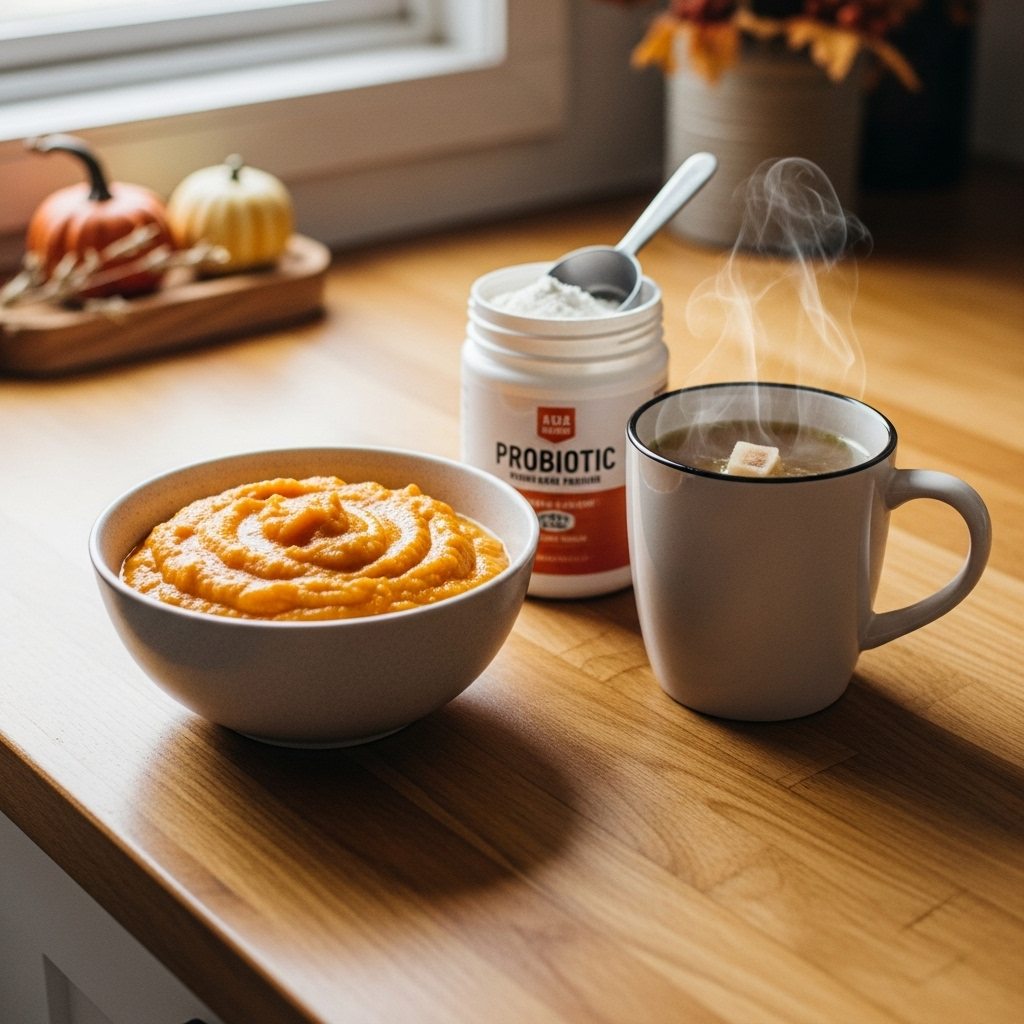Probiotics + Pumpkin or Bone Broth: Safe Combos?

Many pet owners ask whether it’s safe and helpful to mix probiotics with plain canned pumpkin or bone broth when treating digestive upset or just supporting gut health. Short answer: yes, in most cases combining them is safe and can be beneficial — but there are important details about timing, temperature, amounts and ingredients to avoid. This guide explains how to do it safely for dogs and cats, what benefits to expect, and when to check with your veterinarian.
Why combine probiotics with pumpkin or bone broth?
Probiotics are live beneficial bacteria that can help normalize intestinal flora, support digestion and immune function, and reduce diarrhea in some situations. Pumpkin provides soluble and insoluble fiber that can help with both diarrhea (by absorbing excess water) and constipation (by adding bulk). Bone broth is a soothing, hydrating liquid that can entice a picky or sick pet to drink, and provides minerals and gelatin that may support gut mucosa.
Common benefits
- Improved stool consistency from combined probiotic and pumpkin fiber.
- Increased palatability and hydration with bone broth, making it easier to administer probiotics.
- Gentle, supportive care for short-term digestive upset when underlying illness is mild or previously diagnosed.
How to combine safely: step-by-step
- Choose the right products: Use a probiotic formulated for pets when possible. For pumpkin, use plain canned pumpkin (100% pumpkin puree), not pumpkin pie filling. For bone broth, use low-sodium, onion/garlic-free broth or make your own without added seasonings.
- Mind the temperature: Heat kills live probiotic cultures. If you’re using bone broth warmed for palatability, let it cool to lukewarm before adding the probiotic. Cold pumpkin is fine to mix directly.
- Start with small amounts: For dogs, a teaspoon to a tablespoon of pumpkin is common depending on size. Cats and toy breeds need much smaller amounts (a quarter to half teaspoon). Follow probiotic product dosing instructions and your vet’s guidance.
- Mix thoroughly: Stir the probiotic into the pumpkin or broth so it’s evenly distributed and easier to eat.
- Watch for reactions: Mild gas or soft stools may occur initially as the gut flora adjusts. If diarrhea worsens, you see vomiting, lethargy, or blood in stool, stop and contact your vet.
Special precautions and common pitfalls
Avoid these ingredients
- Onions, garlic, leeks, chives — toxic to dogs and cats and sometimes present in commercial broths.
- Added salt, excessive fat, or spices in store-bought broths that can upset the stomach or trigger pancreatitis.
- Sugar or sweeteners (xylitol is toxic to dogs) — avoid yogurts or kefirs with added sugar or artificial sweeteners.
When not to combine
- Pets with severe dehydration, vomiting, bloody diarrhea or signs of systemic illness should see a veterinarian first — supportive home measures alone may be unsafe.
- Pets on immunosuppressive therapy or with severe immune compromise should have probiotic use discussed with a vet, as rare infections have been reported in vulnerable patients.
- Pets with pancreatitis or high-fat sensitivity should avoid fatty bone broths; use a low-fat or skimmed option.
Practical tips for different probiotic formats
- Powders and capsules: Mix powder into pumpkin or sprinkle into cooled bone broth. If using capsule, open and mix contents if the product allows.
- Chews or treats: Offer directly or crumble into a small spoonful of pumpkin to disguise taste.
- Yogurt/kefir: Choose plain, unsweetened, and low-lactose options. These are not ideal for all pets; check tolerance first.
How long until you see results?
Mild improvements (less gas, firmer stools) can occur within 24–72 hours. For persistent issues expect to assess over 1–2 weeks. If there’s no improvement or the condition worsens, consult your veterinarian for diagnostics and targeted therapy.
Pros and Cons
| Pros | Cons |
|---|---|
| Can improve stool consistency and hydration; makes probiotics easier to give | Heat from broth can kill probiotic cultures if added when too hot |
| Pumpkin is inexpensive, widely available, and gentle on guts | Too much pumpkin can cause loose stools or excess calories |
| Bone broth is palatable and encourages fluid intake | Commercial broths may contain onions, garlic, salt or fat that are harmful |
FAQ
1. Can I give probiotics and pumpkin at the same time every day?
Yes — for short-term support or ongoing gut health you can give probiotics with a small amount of pumpkin daily, following dosing guidelines for your pet’s size. Monitor stool and appetite.
2. Will warming bone broth kill the probiotics?
Yes if the broth is hot. Let broth cool to lukewarm or room temperature before adding the probiotic to protect live cultures. Alternatively, give the probiotic separately from a hot broth.
3. How much pumpkin should I give my dog or cat?
General guidance: dogs — 1 teaspoon to 1 tablespoon depending on size (tiny breeds at the low end, larger dogs up to a tablespoon). Cats — a quarter to half teaspoon. Always start small and adjust. Consult your vet for specific dosing.
4. Is homemade bone broth safe?
Homemade bone broth can be safe if made without onions/garlic, not overly fatty, and strained to remove small bone fragments. Avoid giving pets cooked bones.
5. How long should I use probiotics for digestive upset?
Short-term courses are often 5–14 days for mild issues; chronic or recurrent problems may need longer treatment or diagnosis. Follow your veterinarian’s plan.
Key Takeaways
- Combining probiotics with plain canned pumpkin or cooled bone broth is generally safe and can help with palatability and stool consistency.
- Avoid hot broth, added onions/garlic, high salt, sugars and xylitol-containing products.
- Start with small amounts and monitor your pet’s response; discontinue and consult your vet if symptoms worsen.
- Use pet-formulated probiotics when possible and discuss use with your veterinarian for very young, elderly or immunocompromised pets.
Disclaimer: This information is educational and not a substitute for veterinary care. If your pet has severe, persistent, or worsening symptoms (vomiting, bloody stool, lethargy, dehydration) seek veterinary attention promptly. Check with your veterinarian before starting new supplements, especially for pets with chronic health conditions or on medications.

Leave a Reply